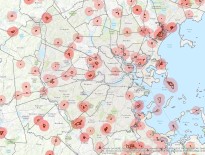Historically, each real estate boom has ultimately become a bust to some degree. What goes up in real estate usually goes down. The degree of “down” almost always depends on the intensity and corresponding speed of price increase on the “up” side. Generally, if the up side is gradual, the down side will be slight or mild. However, if that up side was fast and intense with big, rapid price increases, the odds are that the down side will likely mirror it.
The real estate market is dynamic, constantly changing – directly impacting homebuyers and sellers in four major ways: home values and trends; marketing time; cost of sale and who has the negotiation advantage.
Defining The Market
The very best way to determine the current real estate market and trend in a specific metropolitan area, community, neighborhood or price range, is to know the current supply (and prior three- to six-month trend) of unsold home listings in these different geographic areas and price range groupings. “Supply” is expressed by the number of months it would take to sell the current inventory of unsold homes at the current rate of home sales.
A six-month supply is indicative of what is referred to as a “balanced market” – the number of sellers and buyers about equal with home values holding steady. Other indications of a balanced market are normal home marketing time (60-90 days), normal seller’s cost of sale and neither seller nor buyer having a negotiation advantage. Major negotiations involve price and the key terms of sale, such as the amount of deposit, mortgage and property inspection contingencies and time to close.
Five Market Conditions
There are five distinct market conditions with corresponding impact to buyers and sellers:
Intense Sellers’ Market (less than 4-month supply of unsold home listings) – Many more buyers than sellers: home values rapidly increasing; marketing time greatly reduced; lowest sale cost; negotiations strongly favoring sellers.
Moderate Sellers’ Market (4.1- to 5.9-month supply) – Slightly more buyers than sellers: home values slightly increasing; marketing time slightly reduced; lower sale cost; negotiations slightly favoring sellers.
Balanced Market (6- to 6.9-month supply) – Equal number of buyers and sellers: home values holding; normal marketing time; normal sale cost; negotiations favoring neither seller nor buyer.
Moderate Buyers’ Market (7- to 8.9-month supply) – Slightly more sellers than buyers: home values slightly decreasing; marketing time slightly increased; higher sale cost; negotiations slightly favoring buyers.
Intense Buyers’ Market (over 9-month supply) – Many more sellers than buyers: home values rapidly decreasing; marketing time greatly increased; highest sale cost; negotiations strongly favoring buyers.
It’s important to point out that any broad market area – such as a suburban area or county, or even a specific community – can contain a number of micro-markets made up of specific neighborhoods and/or price ranges. These micro-markets can differ greatly from the macro-markets in which they exist.
Where to Get The Data
For homebuyers interested in buying a home in a specific community, this data is usually easily available from real estate agents through their local Multiple Listing Service (MLS). As stated above, broad community data should be viewed as a macro-market which provides a general feel for the overall community – not the specific price range or part of town in which a buyer may be interested. Most MLS systems can also provide data on unsold home inventory in a specific community and price range, which will give buyers a very clear picture of the type of market they’re buying into – and therefore, the advantages or disadvantages they will face.
For home sellers looking to set a competitive price on their home, this exercise is simplified, as a seller’s property can be matched (by MLS data) to recently sold and currently unsold similar homes in the same community or similar nearby communities.
Homes Don’t Exist In A Vacuum
For home sellers, the single, most important thing to understand is that their home is going to be compared to other homes for sale that are similar in price range and location. That location may not only be in the town their home is located in, but a specific, similar neighborhood in an adjacent or nearby town. Studies by the National Association of Realtors document that the typical buyer looks at no less than 10 homes for sale before making the final decision to buy one. If a seller’s home does not compete with the price, condition, quality and location of those homes competing for buyers, that home will not sell.
For home buyers, the single, most important thing to understand is the market conditions that exist in the price range and locations they are interested in.
Walter Hall, founder of Walter Hall Realtors, The Hall Institute of Real Estate and Relocation Resources International (RRI), has recently published his fifth book, All Things REAL ESTATE. For more information, please visit www.allthingsrealestate.org.








